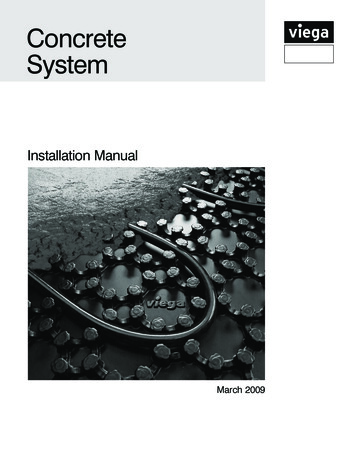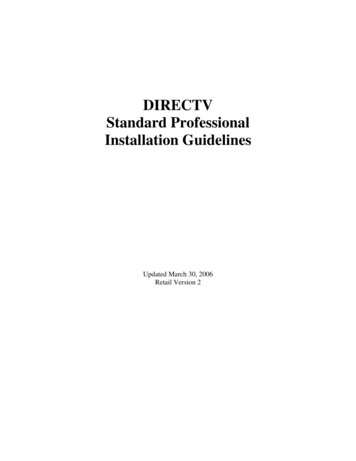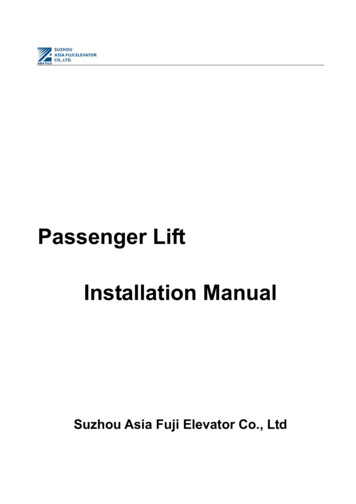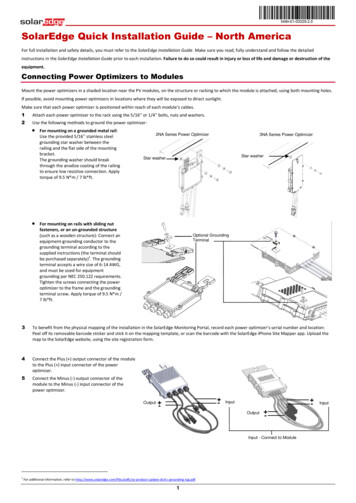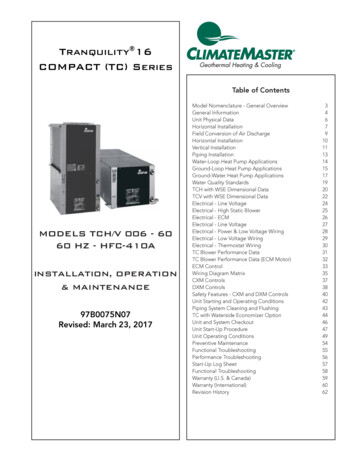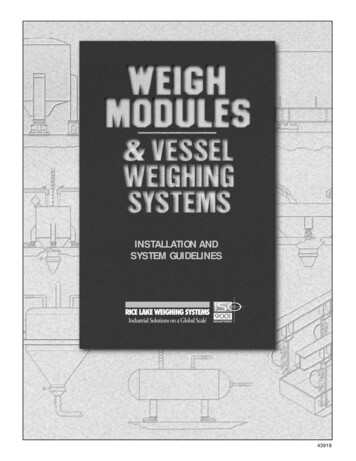
Transcription
INSTALLATION ANDSYSTEM GUIDELINES43918
CONTENTSVessel Weighing System Design . Section 1Bulk Material Weighing Systems Load Introduction Principles Maximizing System Accuracy Selecting Number of Supports & Load Cell Capacity Choosing the Correct Load Cell CalibratingThermal Expansion of Vessels & Stay Rods Calculating Tank Volumes Densities of Common Materials Load Cell Bolt Torque Values Wind and Seismic Effects on Vessel StabilityWeigh Modules . Section 2Single-End Beam Load Cell Modules Double-End Beam Load Cell Modules Compression CanisterLoad Cell Modules S-Beam Load Cell Modules Mounting Assemblies and Compatible Load CellsVessel Attachments . Section 3Attaching Piping to Weigh Vessels Piping Guidelines Vessel Restraint Systems Low-AccuracySystems: Partial Mounting on FlexuresInstallation & Service Tips . Section 4Before Installing Determining Microvolts per Graduation Load Cell Mounting Hardware SafetyGuidelines Load Cell Trimming Load Cell Troubleshooting Selecting Replacement Load Cells Load Cell Wiring Guide Calibrating Vessel Weighing SystemsGlossary . Section GAll vessel weighing system installations should be planned by a qualified structural engineer.! Warning This manual is intended to serve only as a general guide to planning, installation, and servicing of thesesystems; no attempt has been made to provide a comprehensive study of all possible system configurations.Copyright 1997 Rice Lake Weighing Systems. All rights reserved. Printed in the United States of America.Specifications of products described in this handbook are subject to change without notice.December 1997
SYSTEM DESIGNVESSEL WEIGHING SYSTEM DESIGNBulk Material Weighing Systems . 1-2Custody Transfer .Material Proportioning .Loss in Weight .Common Hopper Scale Arrangements .Contents1-21-21-21-3Load Introduction Principles. 1-6The Ideal. .Angular Loading .Eccentric Loading .Side Loading .Twisting Loads .1-61-61-61-71-7Maximizing System Accuracy . 1-8Environmental .Load Cell and Mount .Mechanical/Structural .Calibration .Operational Considerations .1-81-81-81-81-8Selecting Number of Supports & Load Cell Capacity . 1-9Number of Supports . 1-9Load Cell Capacity . 1-9Choosing the Correct Load Cell . 1-10Environmentally Protected . 1-10Hermetically Sealed . 1-10International Protection (IP) Rating Guide . 1-11Calculating Thermal Expansion of Vessels & Stay Rods . 1-12Stay Rod Expansion/Contraction . 1-12Vessel Expansion/Contraction . 1-12Calculating Tank Volumes . 1-14Formulas for Various Tank Shapes and Sections .1-14Calculation Examples . 1-17Densities of Common Materials . 1-19Load Cell Bolt Torque Values. 1-23Wind and Seismic Effects on Vessel Stability . 1-241-1
aaaaaaaaSYSTEM DESIGNBulk Material Weighing SystemsaBulk Material Weighing SystemsBulk materials are weighed for various reasons. Although this discussion focuses on the weighing of bulk solids, many of the principlesare equally applicable to the weighing of bulk liquids. For the sake of convenience, we have classified bulk material weighing into threegeneral types:Custody TransferFigure 1-3 shows several materials being mixed to a given recipeand batched one at a time into a single weigh hopper. As allingredients are weighed in the same weigh hopper, the weighingsystem must be linear to achieve correct proportioning. It does notneed to be calibrated accurately if the final net weight of productis not critical.aaaaaFigure 1-1Weighing bulk material on a truck scale is a typical example ofcustody transfer weighing where material is being traded fordollars. The filled truck is weighed and the known tare weight ofthe truck is subtracted to determine the net weight of product. Thismay be done for invoicing or inventory-control purposes. Typically, achieving a predetermined weight is not important in thissituation. What is important is knowing how much materialentered or left the facility.Figure 1-3Loss in WeightMaterial ProportioningFigure 1-2 shows various ingredients being weighed on separatescales, then mixed. Each scale must be accurate, or there couldbe a detrimental effect on the proportions of each ingredient inthe finished product.Figure 1-4 shows a situation where the weigh hopper is first toppedup and when the filling process stops, the material is fed out at acontrolled rate. The total amount of material supplied to theprocess may be important, but the rate at which product is fed intothe batching process from the weigh hopper is usually moreimportant.Figure 1-2Figure 1-41-2
aaaaaaSYSTEM DESIGNaBulk Material Weighing SystemsCommon Hopper Scale ArrangementsA. One of the simplest hopper weighing systems is illustratedbelow in Figure 1-5. The weigh hopper may be filled using afeed conveyor, front-end loader, auger, etc., and the materialmay be removed from the hopper using a discharge conveyor.C. A conveyor-fed system can be improved by adding an uppersurge hopper as shown in Figure 1-7. The surge hopper allowsthe conveyor to be run continuously and isolates the weighhopper from the sometimes erratic flow of material from theconveyor.aaaaFigure 1-5Advantages of this system are: Low cost compared to other systems. Low overall height.Disadvantages of this system are: Slow fill and discharge (low throughput). Difficult to achieve an accurate prescribed weight becauseof inconsistency in input material flow.B. Figure 1-6 below illustrates a weigh hopper positioneddirectly under the storage silo.Advantages of this system are:Figure 1-7Advantages of this system are: Weigh hopper isolated from the feed conveyor. The input conveyor can run continuously. Surge hopper serves as a buffer to smooth out demand. 2-speed fill is possible. Faster fill and higher throughput possible.Disadvantages of this system are: Higher overall height. Higher cost. More complex controls and mechanical arrangement.Figure 1-6 The weigh hopper is gravity-fed, simplifying the feed processand providing a more uniform flow.Faster fill cycle and hence greater throughput.2-speed fill may be used for greater target accuracy.Disadvantages of this system are: Higher overall height. Material must be conveyed higher to storage silo.1-3
aaaaaaaaaaSYSTEM DESIGNBulk Material Weighing SystemsaaaaaD. This arrangement is similar to Example C, however, a lowersurge hopper has been added to speed up the discharge cycle.This system, shown in Figure 1-8, is typically used in multidraft grain loadout systems where multiple drafts are required to fill a rail car or barge. The weight of each draft canbe accumulated and the target weight of the final draftadjusted to achieve the desired car net load.Figure 1-9F. Figure 1-10 illustrates a loss in weight system. This is usedwhere a process needs a batch of material (not more than thecapacity of the weigh hopper), but that material needs to befed to the process at a controlled rate.Figure 1-8Advantages of this system are: Weigh hopper isolated from feed conveyor. Surge hopper serves as a buffer to smooth out demand. 2-speed fill is possible. Faster fill, discharge, and throughput possible.The process starts by filling the hopper with at least enoughmaterial for the upcoming process. The fill is then stoppedand the discharge commences. The rate at which the discharge takes place is controlled by monitoring the “loss inweight” of the hopper and then modulating the dischargerates to maintain the desired flow rate. The discharge may beended at the completion of the process step, or when a specificamount of material has been discharged.Disadvantages of this system are: Higher overall height. Higher cost. More complex controls and mechanical arrangement.The systems described up to this point deliver a single material inpulses rather than from a continuous flow. They may be used forin-plant process weighing or custody transfer. Figures 1-9 and 110, described below, provide a continuous material flow and aremore often used for process weighing.E. Figure 1-9 illustrates a single storage silo with two weighhoppers suspended underneath. This arrangement can beused to provide material continuously to a process. As onehopper is emptying, the other can be filling If the system issized correctly, there is no interruption to the material flowon the discharge belt.Advantages of this system are: Continuous material flow. High throughput possible.Disadvantages of this system are: Higher overall height. Higher cost than pulse discharge systems. More complex controls and mechanical arrangement.1-4Figure 1-10Advantages of this system are: Gives the ability to supply material at a constant rateDisadvantages of this system are: Complex controls and mechanical arrangement Higher cost than pulse discharge systems.
aaaaaaBulk Material Weighing SystemsG. Figure 1-11 illustrates a multiple-ingredient batching system where all the ingredients are weighed one at a time in asingle weigh hopper.SYSTEM DESIGNH. The system illustrated in Figure 1-12 below is a multiingredient batching system which has a separate weigh hopper for each ingredient.aaaFigure 1-12Figure 1-11Advantages of this system are: Lower cost than multiple-weigh hoppers Scale calibration may not be critical, as all ingredients areweighed in a single scale, assuring correct proportions.Disadvantages of this system are: The accuracy of minor ingredients may suffer where the scalecapacity is large compared to the weight of ingredient. System is somewhat slow because each material must bebatched in one at a time, and the cycle cannot repeat until theweigh hopper has been discharged.Advantages of this system are: Weigh hopper capacity can be sized appropriately for eachmaterial so that each weighment is close to the scale capacity,providing greater accuracy. Faster throughput, since all materials can be weighed anddischarged simultaneously.Disadvantages of this system are: Higher cost. Each scale must be accurate to ensure correct proportioning.Note: We recommend that you do not attempt to weigh a batch ofmaterial which is less than 20 scale divisions since the accuracywill be questionable.For example, if a hopper scale has a .5 lb division size, we recommend that you not weigh less than a 10-lb batch on that scale. It’sbetter to weigh minor ingredients accurately on a scale suited tothe purpose, and add those ingredients to the batch by hand. Forexample, if making raisin oatmeal cookies, it may not be too muchof a problem to batch-weigh the raisins along with the oatmeal.However, it may be prudent to weigh the salt on a more sensitivebench scale and hand-add it to the hopper at completion of theweigh cycle.1-5
SYSTEM DESIGNLoad Introduction PrinciplesLoad Introduction PrinciplesA clear understanding of the exact manner in which a load must be placed on a load cell will assist you in both designing a vessel that isto be equipped with load cells, and in choosing the correct type of load cells and mounts for your application.The Ideal.Load cell specifications are derived under laboratory conditions,where load is applied to the cell under near-perfect conditions. Theperformance of load cells in an actual process weighing applicationcan be greatly degraded if care is not taken in the means by whichthe load is applied to the cell.CLCLFigure 1-14If the direction of the force is constant, calibration will compensatefor this and the scale will weigh accurately. However, if the anglechanges as the force is applied, it will cause nonlinearity and ifthere is friction in the mechanical system, hysteresis will also bepresent. Angular loads can be caused by mounts that are out oflevel, a nonrigid foundation, thermal expansion/contraction, structure deflection under load, and the unavoidable deflection of theload cell itself.Figure 1-13Eccentric LoadingFigure 1-13 shows a typical mounting arrangement for a singleended beam. The fixed end is fastened to a “rigid” foundation, whilethe free end is cantilevered to allow downward deflection as load(F) is applied. Under ideal conditions, the mounting surface wouldbe flat, horizontal and perfectly rigid. The load F would be introduced vertically with minimal extraneous forces applied, and theload cell would be totally insensitive to all forces other thanprecisely vertical ones.However, in the real world, load cell mounting and loading conditions are far from ideal. Incorrect loading is by far the mostcommon cause of accuracy problems encountered by servicetechnicians. Understanding the following common load introduction problems will prevent loading errors in your vessel weighingapplication.Though the discussion is confined to single-ended beams, many ofthe principles apply equally to other load cell types.Angular LoadingThis is a condition where the load F is introduced through theloading hole, but at an angle to its center line. This angular forcecan be broken up into its vertical component along the loadinghole center line which the cell will register and its horizontalcomponent at 90 from the center line. This horizontal componentis a side force to which, ideally, the load cell would be totallyinsensitive. For example, if force F is inclined to the load holecenter line at an angle of 5 , then the force registered by the cell isreduced by .4% while a side force of .01F is also applied.1-6Figure 1-15This is a condition where the force F is applied vertically to the cell,but its line of action is shifted away from the vertical line throughthe loading hole. This is not a detrimental condition if the force isapplied consistently at the same point, since calibration willcompensate for this effect. However, if the point of applicationmoves horizontally as the scale is loaded, it will cause nonlinearityand possibly hysteresis. Eccentric loads may be caused by poorlydesigned mounting arrangements and thermal expansion/contraction of the scale.
SYSTEM DESIGNLoad Introduction PrinciplesFigure 1-18 illustrates a torque of magnitude Fy exerted as theresult of the load F being applied at a distance y from the loadinghole center line.Side LoadingTyFigure 1-16Figure 1-18This is a condition where the vertical force F (which you are tryingto measure) is accompanied by a side force R applied at 90 to F.This force can be constant, but more typically is a force that variesover time and hence affects the linearity and possibly the hysteresisof the scale. The ideal load cell would be totally insensitive to sideloads. However, in practice these extraneous forces do affect theoutput of the cell and two seemingly identical cells can reactdifferently to the same side load. A related condition is the ENDFORCE, P, which is similar to a side force, except that it acts on theend face of the cell. Side forces are the result, typically, of thermalexpansion/contraction, mounts which are not level, and vesseldynamics (caused by mixers, etc.).Mounts which are out of level, thermal expansion/contraction,structure deflection under load and dynamic side forces (caused byrotating mixers, etc.) all cause twisting of the load cell. Since theseforces tend to vary in magnitude as a function of time, temperatureand/or load, the effects are not predictable, and will degrade systemaccuracy.Twisting LoadsTThCLh1(a)(b)Figure 1-17Typically, a side force does not act exactly at the neutral axis andhence produces a torque or twisting effect in addition to the sideforce. A load cell can be subjected to a torque (T) in a number ofways. Figure 1-17 (a) illustrates a condition where the line of actionof a side force is moved away from the neutral axis by a distance hresulting in a torque of Rh. Figure 1-17 (b) illustrates a situationwhere the load is hung from the cell using a bolt. Any side forceapplied by this arrangement has a much larger twisting effect onthe cell because of the increased distance h1 to the neutral axis.1-7
SYSTEM DESIGNDesign ElementsMaximizing System AccuracyHigh-accuracy systems are generally considered to have system errors of .25% or less; lower accuracy systems will have system errorsof .50% or greater. Most weight indicators typically have an error of .01%, hence, the main source of error will be the load cells and,more importantly, the mechanical arrangement of the scale itself. In vessel weighing, each installation is unique in terms of themechanical arrangement, site conditions and environmental factors. Therefore, it is impossible to be specific in this publication aboutthe system accuracy that can be achieved. The first requirement is to determine what the customer’s accuracy expectations/requirementsare, then design the system accordingly. Grouped under various subheadings below are various recommendations that contribute to highaccuracy. It will not be possible to comply with all these recommendations; however, they should be kept in mind when designing a system.EnvironmentalMechanical/Structural Install the vessel in a controlled environment where seasonaltemperature fluctuations are minimized. If this is not feasible, use load cells with temperature compensation specifications that will allow satisfactory performance over the expected temperature range.Use a metal shield to protect the load cells from radiant heatsources. Use an insulating pad between the vessel and load cellmount if heat is being conducted.If thermal expansion/contraction of the vessel is expected,choose a mount which will allow unhindered lateral movement. If stay rods are required, position them so that thermally-induced movement is minimized. See Vessel RestraintSystems in Section 3 for more information.Place the vessel indoors, if possible, where it will be protectedfrom wind and drafts.Do not place the vessel in an environment where its supportstructure is subject to vibration. Ensure that vibrations arenot transmitted via attached piping or stay rods.Select load cells and mounts that will give the degree ofcorrosion protection required.Use load cells that have the degree of environmental protection required for the application. For example, avoid possibledrifting problems with standard load cells in washdown applications by specifying hermetically-sealed cells. Calibration Load Cell and Mount 1-8Choose load cells whose accuracy is consistent with thedesired system accuracy.Do not grossly oversize the load cells; see Load Cell Capacityon page 1-9. Best accuracy will be achieved when weighingloads close to the vessel capacity. As a general rule, do notattempt to weigh a load of less than 20 graduations.If it is not possible to trim the corners, use load cells withmatched outputs, particularly if the vessel is not symmetricaland/or the material is not self-leveling. Otherwise, use apretrimmed junction box.Support the vessel entirely on load cells; do not use dummycells or flexures that would hinder a good calibration. SeePartial Mounting on Flexures on page 3-11.Use proven load cell mounts that will provide optimal loadingconditions.Orient the mounts as recommended in the installation manual.Support the load cell mounts on a rigid structure; this willensure a high natural frequency and reduce the amount ofbounce and instability. All support points must be equallyrigid to avoid tipping of the vessel as load is applied. Minimizeinteraction between adjacent weigh vessels mounted on thesame structure. Vehicular traffic must not cause deflection ofthe vessel’s support structure.Ladders, pipes and check rods, etc. should not be allowed toshunt the weight that should rest on the load cells.Where piping or conduit must be attached to the vessel, usethe smallest diameter acceptable for the application. Use thelongest unsupported horizontal length of pipe possible toconnect to the vessel.Use an indicator that is EMI/RFI protected. Provide grounding and transient protection in accordance with themanufacturer’s recommendations. In general, take measuresto reduce electrical interference.Use a good-quality junction box which remains stable withchanging temperatures. Look for a junction board which hasa solder mask at a minimum and which preferably isconformally coated also. Ensure that the enclosure is suitedto the environment.Design in a convenient means of hanging weight from thecorners of the vessel to trim the load cell outputs and forcalibration. Use weights as described above, or known weightof material to perform the calibration. See Calibrating VesselWeighing Systems in Section 4.Operational Considerations Maintain an even and consistent flow of material.Avoid simultaneous fill/discharge of weigh vessel.Slow down the filling cycle as much as possible and/or use a2-speed fill cycle.Reduce to a minimum the amount of “in flight” material.Use preact learning to predict the optimum cutoff point basedon past performance.Use Auto Jog to top off contents after fill.If possible, switch off any vibrating or mixing equipmentwhile the weight is being determined.Reduce to a minimum the surging of liquids while a weightreading is being taken.
VESSEL WEIGHING SYSTEMSDesign ElementsSelecting Number of Supports & Load Cell CapacityNumber of SupportsLoad Cell CapacityThe number of supports to be recommended is dependent on thegeometry, gross weight, structural strength and stability of thevessel. The number of supports chosen for a vessel obviouslyinfluences the capacity of the load cells required. In general, nomore than eight supports should be used. It becomes more difficultto get even weight distribution on all supports as the numberincreases beyond three. Below is a look at a number of examples.It is vital to the performance of a weighing system to select loadcells of the correct capacity. Here are some guidelines:Suspended VesselsThese vessels are very often suspended from an existing structurewhich will sometimes dictate how many supports will be used. Ingeneral, one or more supports may be used. Using three supportsor fewer has the advantage of not requiring adjustment ofthe length of the support linkages to distribute the loadequally between all supports (assuming the cells are arrangedsymmetrically on the vessel). All load cells selected must be of the same capacity. Estimate the vessel dead weight, including all piping, pumps,agitators, insulation and vessel heating fluids. Add the maximum live weight of product to be weighed to thedead weight. This is the gross weight of the vessel andcontents. Divide the gross weight by the number of legs or supportpoints. This is the nominal weight which will be carried byeach load cell. Select a load cell with a capacity somewhat greater than thenominal weight. The following should be considered whendetermining how much greater the load cell capacity shouldbe:Upright cylindrical vessels in compressionThe most convenient method of mounting is with three supportsarranged at 120 degree intervals. Correct weight distribution isinherent to 3-point support and is preferred whenever possible.With tall slender vessels or vessels subject to fluid sloshing, windor seismic loads, stability against tipping becomes a consideration.In these situations, four or more supports should be considered.See Appendix section on wind and seismic effects.Square, rectangular or horizontal cylindricalvessels mounted in compressionBecause of geometry, it is usually most convenient to mount thesevessels on four supports, close to each corner. Higher capacitiesmay, of course, require more than four.1.Is your dead weight accurate?2.Will the load be evenly distributed on all cells?3.Is the vessel fitted with an agitator or subjected to shockloading?4.Is it possible the vessel will be overfilled, exceeding yourlive weight value?5.Will the vessel be subjected to wind or seismic loading?For more information, see Wind and Seismic Effects onVessel Stability.A good rule of thumb is to select a load cell with a capacity 50 –100% in excess of the calculated nominal load per cell. Once theload cell capacity has been determined, check that the live weightsignal is adequate for the instrumentation selected; see Section 4for information on how to determine the microvolt-per-graduation for your system. This is particularly important when the ratioof dead weight to live weight is high. Additional factors to consider:Load Cell Construction Material — In a corrosive environment, stainless steel outperforms nickel-plated alloy steel.Load Cell Protection — The ultimate degree of protectioncan be achieved with hermetically-sealed load cells whichensure the integrity of the strain gauge section of the cell incorrosive or washdown applications.Cable Length — Check that the standard cable length willbe adequate for your installation. Longer cable lengths areavailable on special order. See page 2-22 for compatibility information on mounts andload cells by capacity. Capacity requirements may limitpractical applications of many models.1-9
SYSTEM DESIGNDesign ElementsChoosing the Correct Load CellMisuse of any product can cause major cost and safety problems;load cells are no exception. Unfortunately, the load cell protectionrating systems used in the industry today are inadequate in someways. That’s why Rice Lake Weighing Systems, with years of loadcell experience, has developed its own rating system for load cells.Our system categorizes load cells in two major groups: hermetically-sealed (HS), and environmentally-protected (EP). Hermetically-sealed cells ar
weigh hopper has been discharged. Note: We recommend that you do not attempt to weigh a batch of material which is less than 20 scale divisions since the accuracy will be questionable. For example, if a hopper scale has a .5 lb division size, we recom-mend that you not w



